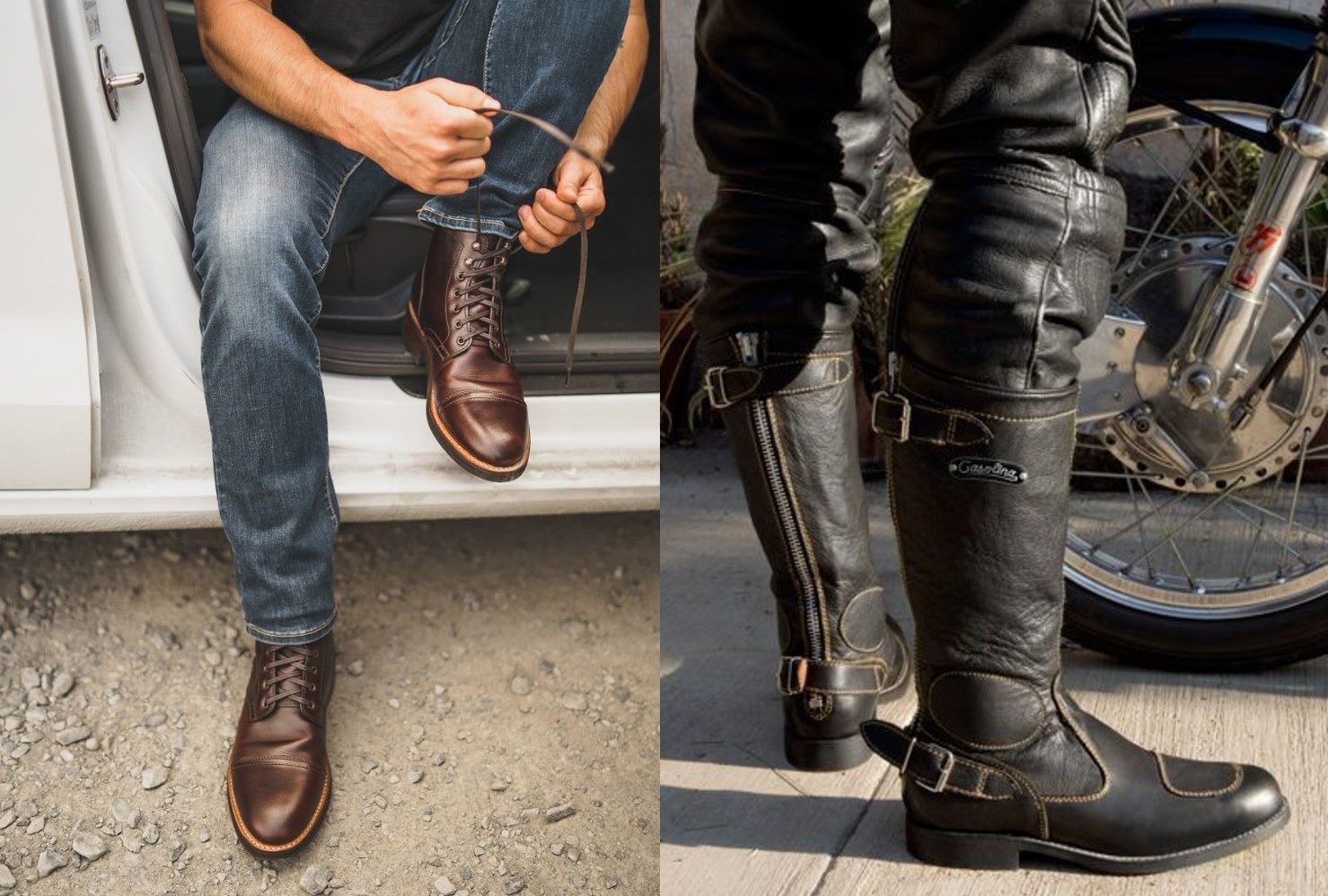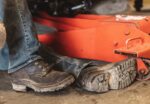There is not much difference between a work boot and a motorcycle boot, as what we look for in a solid pair of boots is safety and comfort. And both work and motorcycle boot provides us that.
However, there are considerable differences between the two and that is why they are employed for different activities.
The most noticeable difference between a work boot and a motorcycle boot is the extra padding in the toe designed in motorcycle boots to protect it. Motorcycle boots are thicker and heavier than work boots, and they are built with thick layers to protect your legs from impact during a crash.
Let us have a look at the differences.

Work boots Vs Motorcycle boots Differences
1.) Flexibility
Motorcycle boots are more flexible than work boots. Well, it needs flexibility to allow the wearer to change gears easily without hassle.
Motorcycle boots also have flexing panels at both the rear and front to allow for better movement without stretching or discomfort.
2.) Physical attributes
Work boots generally come in laces that are there to keep your feet in place. However, motorcycle boots avoid using shoelaces and instead opt for velcro to secure them to the wearer’s foot to avoid any hassles.
Also, laces might prove to be dangerous as they can get stuck anywhere in the wheels while driving posing some serious danger.
3.) Toe protection
While most work boots have toe protection, such as a steel cap or a composite cap, the upper toe of a motorcycle boot is typically made of hard material.
They don’t have any toe protection. Steel-toed boots are not appropriate for motorcycle riding because they do provide good abrasion protection, but lack ankle protection and typically lack a reinforced sole to protect the foot.
4.) Ankle protection
The most significant distinction is that motorcycle boots have lateral crush protection. The majority of motorcycle boots include a plastic cup to help protect the ankle bone during a slide. Which you won’t find in regular boots, let alone protective work boots.
Motorcycle and Work Boots Comparison Table
| Work boots | Motorcycle boots | |
| Material | Rubber, leather | Thick, heavy leather |
| Physical attributes | Comes with shoelaces | Fastened to the wearer’s foot with Velcro. |
| Safety features | Good | Good |
| Flexible | Not very flexible | It is flexible |
| Durable | Yes | Yes |
| Toe protection | Yes (steel toe, composite toe) | No |
| Heels | Raised heels | Wide and low |
| Ankle protection | No | Yes |
| Water resistance | Yes | Yes |
| Grip | Good | Excellent |
| Shock and abrasion resistance | Good | Good |
| Insulation | Yes | Yes |
Can you wear work boots while riding a motorcycle?
Your boots are what your helmet is to your head, this is plain and simple. Because anything less than a proper pair of motorcycle boots will eventually cost you your legs or worse.
Your regular work boots aren’t designed for extreme situations and that is why you require motorcycle boots while you are riding your bike.
If you want to stay safe on the road, you’ll want work boots with these features:
-
-
- Soles that are slip-resistant.
- Low-heeled boots.
- Shin shielding.
- Reinforced soles and upper.
- Cushioning at the ankles, heels, and toes.
- No laces.
- Good impact resistance.
- High tensile strength.
- Ample wiggle room that isn’t too restricted.
-
What should you look for in a pair of motorcycle boots?
To be more specific, you’ll need boots that are:
1.) Comfortable
Comfort is an important factor because uncomfortable footwear adds an extra layer of distraction and fatigue that you’ll want to avoid as much as possible, so choose a pair that gives your feet just the right amount of wiggle room and lets your feet breathe.
2.) Low-heel
A high heel in your boot can make it difficult to properly place your foot on your motorcycle’s peg, however, a completely flat sole increases your chances of slipping, which can lead to disaster when riding at high speeds. And that is why soles with low heels are the most appropriate while riding.
3.) Protection
A good pair of motorcycle riding boots will have protective reinforcements and shanks to protect your heels, ankles, and toes, and should extend to the shin because no muscles cover the shin bone, making it one of the most vulnerable parts of the legs.
Riding a bike is filled with hazards that can happen any moment, that is why you need to be careful and protected.
You can look for these safety codes on your boots-
‘IPA’– Footwear meeting the requirements for ankle impact protection.
‘IPS’– Footwear meeting the requirements for shin impact protection.
‘WR’– Footwear meeting the requirements for resistance to water penetration.
‘FO’– Footwear meeting the requirements for resistance to fuel oil.
‘WAD’– Footwear meeting the requirements for water absorption/desorption on the insole/insock.
‘B’– Footwear meeting the requirements for upper permeability to water vapour.
‘SRA’, ‘SRB’ or ‘SRC‘- Footwear meeting the requirements for slip resistance.
4.) Durability
Your boots should be able to withstand the heat and cold of the outside environment. When selecting your boots, make sure they’re made to withstand harsh road conditions. After all, your boots are your feet’s first line of defense against debris or anything else that comes their way.
What should you look for in a pair of work boots?
1.) Durable material
Always opt for a long-lasting material like leather or rubber. The most serious issue with low-cost work boots is their lack of durability.
This means that the stitching will come apart after a few uses, causing major issues because water will enter your boots and cause blisters or fungus on your feet.
2.) Steel toes
When it comes to work boots, one of the most important considerations is safety, because without them, your feet are at risk of injury.
Steel toe boots are great because they are designed to relieve the pressure from standing on your toes all day, which can cause pain in the balls of your feet during and after working hours.
3.) Comfort
Keep your comfort in mind, because nothing is worse than working all day in work boots that don’t fit your feet properly.
If they are too small or not wide enough, they will cause irritation and pain, particularly in the heels and ball of your foot, and can lead to blisters and fungus on your feet, which you want to avoid at all costs.
4.) Waterproofing properties
Your work boots should be waterproof so as to keep water out while you’re at work. This is a great feature because if water gets inside your boot, it can lead to discomfort, fungal infections and rashes that can be painful.
So waterproofing will keep moisture away from your skin, allowing you to work comfortably even when it is raining.
5.) Safety features
A safety work boot must have a protective shell that is resistant to at least 200 joules of pressure. That means a solid toe protection, good soles that provide solid grip and strong materials are all that you require in your work boot.
See also: Engineer Boots vs Motorcycle Boots
To conclude, both work boots and motorcycle boots are great in providing comfort and protection in their own respective jobs, but if you’re going to buy a pair of boots, whether for work or for riding a bike, you should invest in quality.
A well-made pair of boots will be safe and comfortable to wear for a long time.







